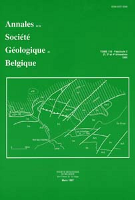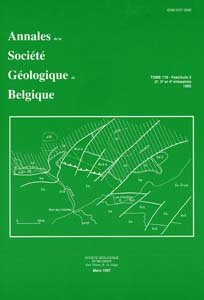- Portada
- Volume 113 (1990)
- Fascicule 2
- Repeated Tethyan influences in the early Campanian to middle late Maastrichtian successions of Folx-les-Caves and Orp-le-Petit (eastern Brabant Massif, Belgium)
Vista(s): 707 (3 ULiège)
Descargar(s): 844 (2 ULiège)
Repeated Tethyan influences in the early Campanian to middle late Maastrichtian successions of Folx-les-Caves and Orp-le-Petit (eastern Brabant Massif, Belgium)

Résumé
Une étude préliminaire des macrofossiles (en particulier des Bélemnites), des foraminifères benthiques et des ostracodes trouvés dans les dépôts de craie du Crétacé récent à Folx-les-Caves et à Orp-le-Petit (Massif de Brabant oriental, Belgique) suggère que la séquence à Folx-les-Caves est d'âge Campanien ancien (post lingua/quadrata Zone). La craie blanche et le tuffeau jaunâtre à Orp-le-Petit ont été déposés pendant le Campanien récent et le Maastrichtien récent moyen, respectivement.
La sédimentation de ces craies sous conditions subtidales peu à très peu profondes, a été temporairement interrompue par des périodes d'émersion (conglomérat à Folx-les-Caves; «hardground» à Orp-le-Petit).
Les assemblages fossiles du Campanien ancien et du Maastrichtien récent moyen, comprennent plusieurs éléments téthysiens distincts parmi la microfaune, les foraminifères et les ostracodes qui sont rares ou absents à partir du Campanien récent jusqu'au Maastrichtien récent ancien, en Belgique et dans le sud-est des Pays-Bas. Les causes possibles de ces incursions téthysiennes répétées sont discutées.
Abstract
A preliminary study of the macrofossils (belemnites in particular), benthic forams and ostracodes in the Late Cretaceous chalk deposits at Folx-les-Caves and Orp-le-Petit (eastern Brabant Massif, Belgium) suggests that the sequence at Folx-les-Caves is of early Campanian (post lingua/quadrata Zone) age. The «craie blanche» and the «tuffeau jaunâtre» at Orp-le-Petit were deposited during the late Campanian and middle late Maastrichtian, respectively.
The sedimentation of these chalks under shallow to very shallow subtidal conditions was temporarily interrupted by periods of emergence (conglomerate at Folx-les-Caves; hardground at Orp-le-Petit).
The fossil assemblages of the early Campanian and middle late Maastrichtian comprise several distinctive Tethyan elements amongst macrofauna, forams and ostracodes which are rare in or absent from the late Campanian to early late Maastrichtian in Belgium and the SE Netherlands. Possible causes of these repeated Tethyan incursions are discussed.
Para citar este artículo
Acerca de: Martin J.M. Bless
Laboratoire de Paléontologie végétale, Université de Liège, Place du Vingt-Août, 7, B-4000 Liège, Belgium.
Acerca de: P.J. (Sjeuf) Felder
Laboratoire de Paléontologie végétale, Université de Liège, Place du Vingt-Août, 7, B-4000 Liège, Belgium.
Acerca de: John W.M. Jagt
Tweede Maasveldstraat, 47, NL-5921 JN Venlo, The Netherlands.






